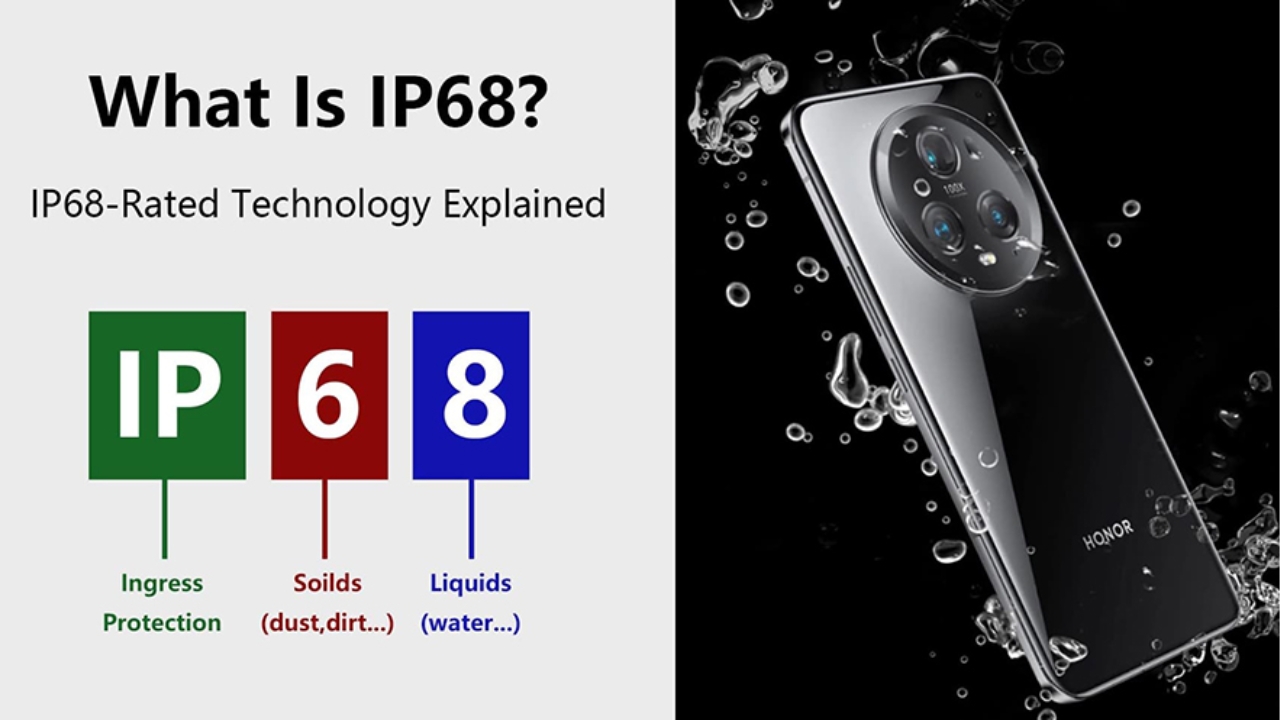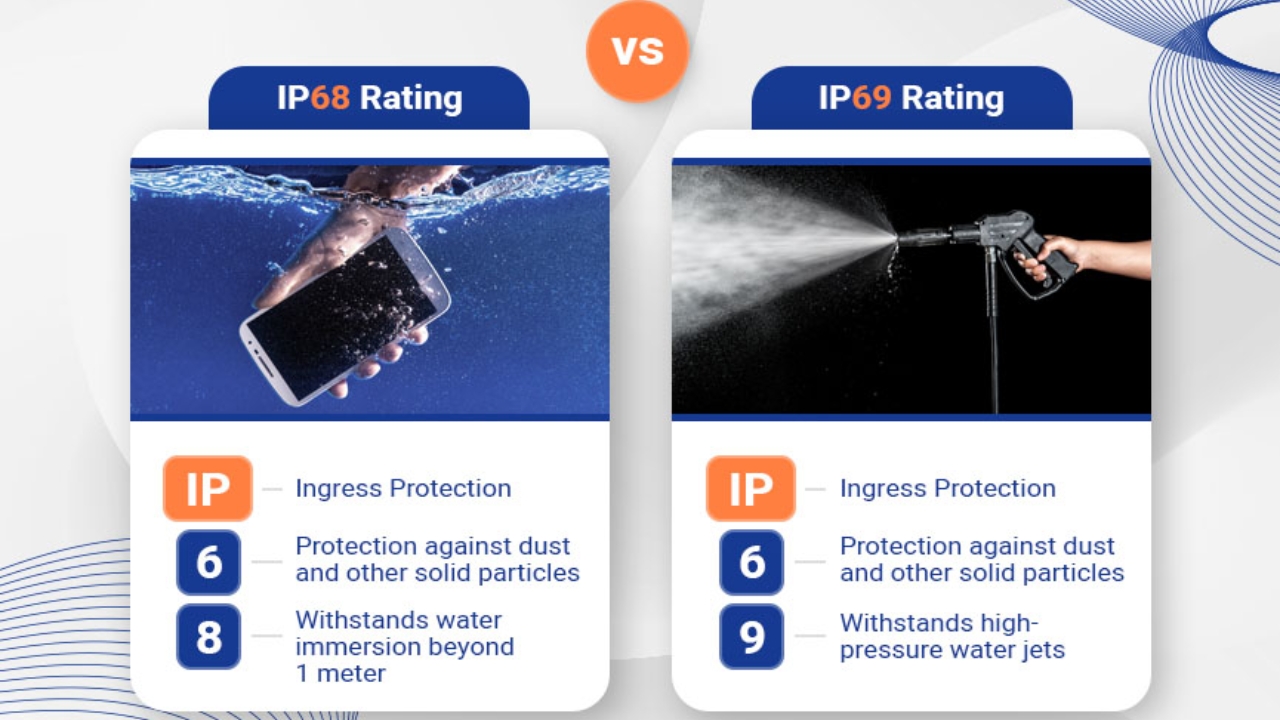IP68 and IP69 ratings offer protection against dust and water. However, there are some differences in their level of water resistance, applications, and testing. Before going into details, let’s know what IP68 and IP69 ratings are.
What is IP68 Rating?

IP68 is a type of Ingress Protection rating that describes the level of resistance a device has to water and dust. The figure “6” in IP68 means complete protection against dust while the “8” stands for resistance to water immersion for 30 minutes and depth of 1.5m. Gadgets like smartphones and smartwatches are IP68-rated.
What is IP69 Rating?

IP69 is the highest IP rating. It provides complete resistance to dust and high-pressure water. The figure “6” in this IP rating represents protection against dust while the “9” means resistance to high-pressure and high-temperature water.
IP69 devices provide protection from submersions, water jets, etc. You will find such devices in outdoor and industrial settings where durability is very important.
IP68 vs IP69: The Differences

Resistance to Water
The water resistance offered by IP68 rating is limited in a way. While this rating offers protection against water and dust, it has its limit. You can submerge an IP68 device in a water depth of 1.5m max and shouldnt stay longer than half an hour. Common devices that have this rating include your smartphone, smartwatches, and some home appliances. This rating applies to devices that have exposure to splashes and accidental immersion in water.
IP69 rating protects against complete water submersion. Devices with this rating can tolerate high-pressure and extreme temperature water jets. You will find such devices in applications with extreme exposure to water immersion. Since they offer complete protection against high moisture, you will find these devices in food processing, medical, marine, and industrial applications.
Testing Methods
IP68 and IP68 products must undergo stringent testing to evaluate their water and dust resistance level. However, their testing process is completely different.
The IP68 testing process requires the use of still water measuring a particular depth. During this process, you need to immerse the device in the water for about 30 minutes. This test is crucial in evaluating the water resistance of an IP68-rated device.
The testing procedure for IP69 rated products is more stringent. In this process, you will need to expose your device to water jets with a high temperature of about 80°C and high-pressure of about 100 bar for a prolonged period. This test helps to ensure the device can withstand extreme water exposure at high temperature and pressure.
Temperature Resistance
IP68 and IP69 ratings differ in terms of their ability to resist extreme temperatures. This is evident in their testing process which requires the use of room-temperature water to test IP68 products. Although they may be able to withstand fluctuating temperatures, they can’t withstand extreme heat.
IP69 devices, on the other hand, can tolerate exposure to extreme temperature water. You can use these devices in applications that need steam cleaning and spraying. Due to their capability to withstand extreme temperature, you will find them in industrial and food processing industries.
Application

IP68 and IP69-rated products excel in different applications. For instance, devices such as smartphones, smart watches, and fitness trackers have IP68 ratings. These devices can only withstand situations like water splashes, rain, and occasional submersion. Also, outdoor equipment like security cameras and lighting fixtures have IP68 ratings.
You use IP69-rated products in applications that require tough cleaning with steam and high-pressure water. For instance, the equipment used in hospitals need steam for sterilization and food processing equipment must be able to withstand high-pressure water. Other applications include industrial machinery and automotive.
Environmental Condition
The environment at which each rating can perform well differs. IP68 rating can only handle exposure to dust, rain, and accidental splashes. Devices with this rating can’t withstand high exposure to steam and high-pressure washes.
This is different for IP69-rated devices. These devices are suitable for use in environments where there is exposure to high-temperature and high-pressure water. Therefore, you can use them in areas where there is a need for rigorous cleaning. Due to the extra protection these devices offer, they are reliable in the environment with constant exposure to dust, water, and extreme heat.
Consumer Electronics
A lot of consumer electronics have IP68 ratings. It is rare to have consumer appliances with IP69 ratings. Smartphones from popular brands like Samsung and Apple mostly have IP68 ratings. This is because these gadgets aren’t suitable for industrial settings. They only offer a certain level of water resistance, meaning they can handle rain, splashes, or accidental submersion. These devices can’t survive prolonged submersion and high-pressure cleaning.
Only a few consumer electronics have IP69 ratings. You can find these ratings in industrial wearables, rugged smartphones, and underwater cameras. These devices can handle water submersion and exposure to high-pressure and steam cleaning.
Cost and Manufacturing Complexity
The difference in the manufacturing complexities of both IP68 and IP69 products is evident in their cost. IP68 devices are less expensive compared to IP69 devices. The materials and processes involved in the manufacturing of IP68 devices contribute to their cost. Since these devices are affordable they are more available. While IP68 products are available in the market and affordable, this is different for IP69 devices.
During manufacturing, IP69 products need advanced engineering and integration of stronger seals. Also, weather-resistant materials are useful in manufacturing these products. Therefore, all these factors contribute to their high cost. As a result, they aren’t as available as IP68 devices.
Conclusion

IP68 and IP69 ratings offer a different level of protection against water and dust. While IP68 devices can tolerate dust, accidental splashes and submersion in water for about 30 minutes, IP69 devices can tolerate much more. IP69 devices can withstand high-temperature and high-pressure water from different angles. These devices offer a higher level of protection.
It is important you understand your needs and application environment before choosing the most suitable IP rating. Also, working with the best manufacturer contributes to the durability and performance of your device.



